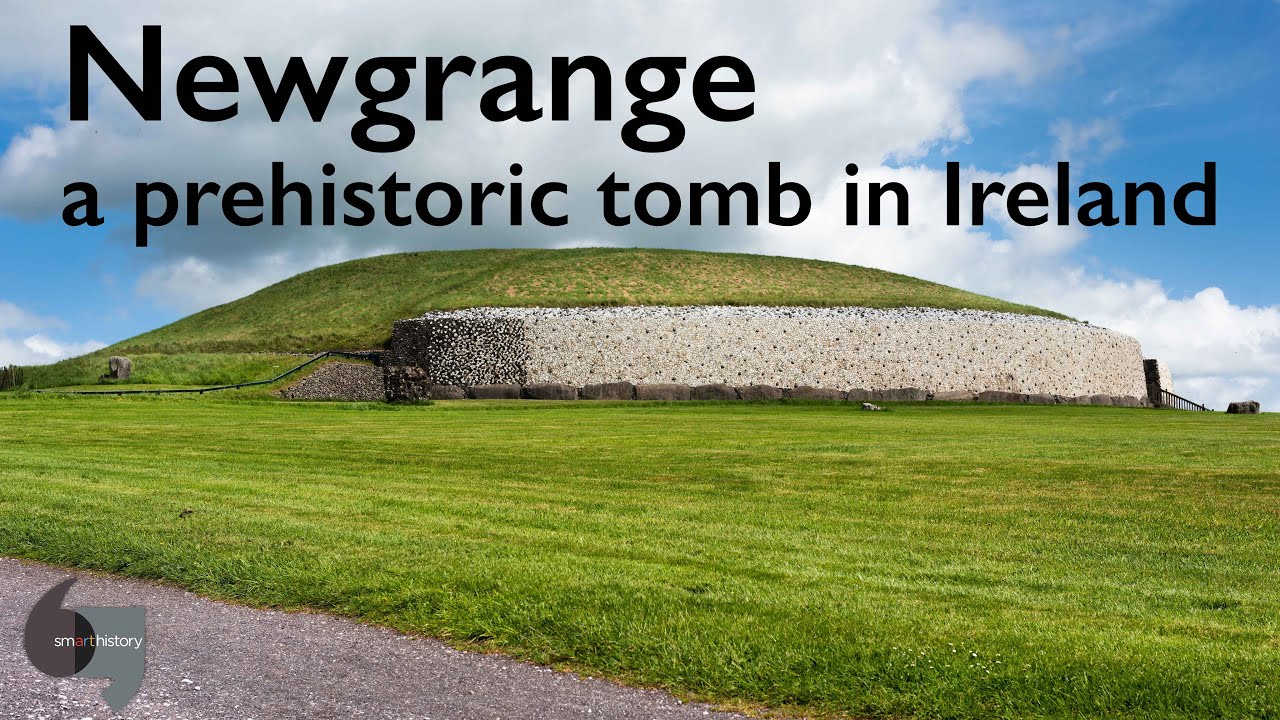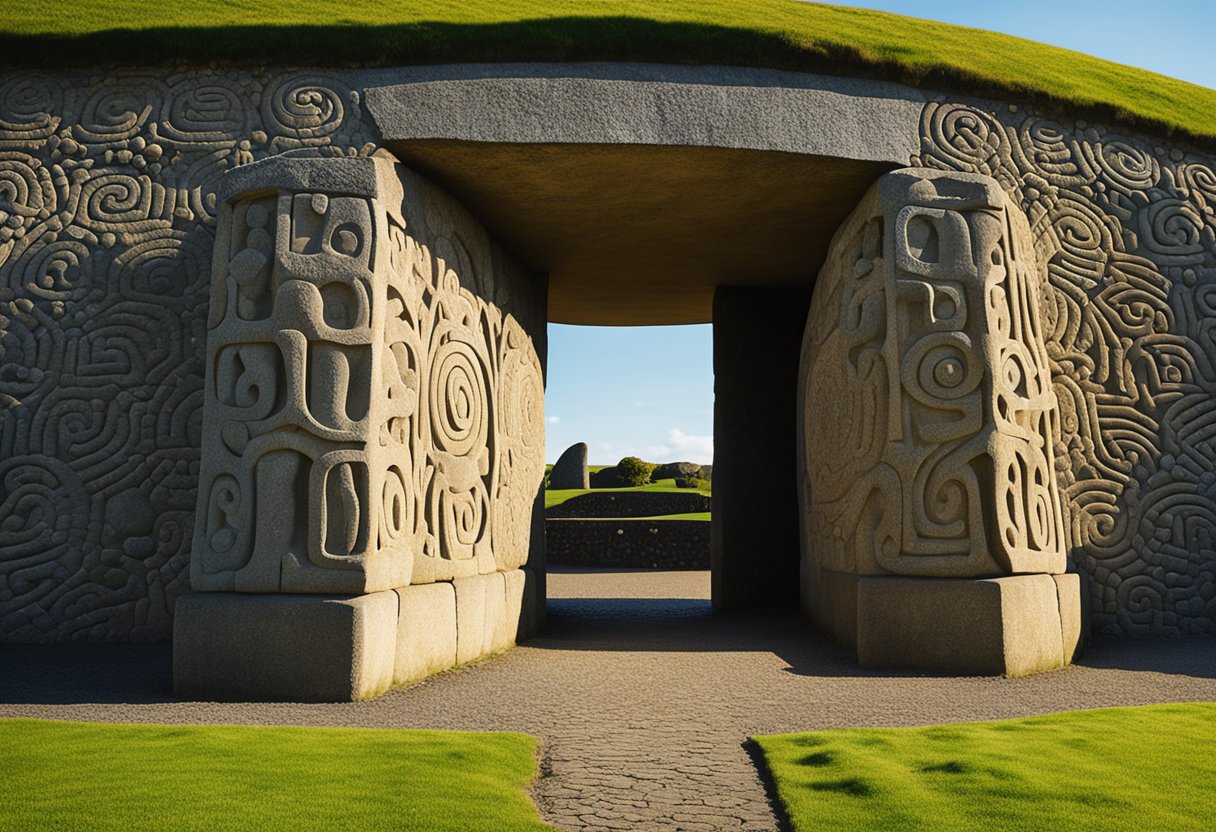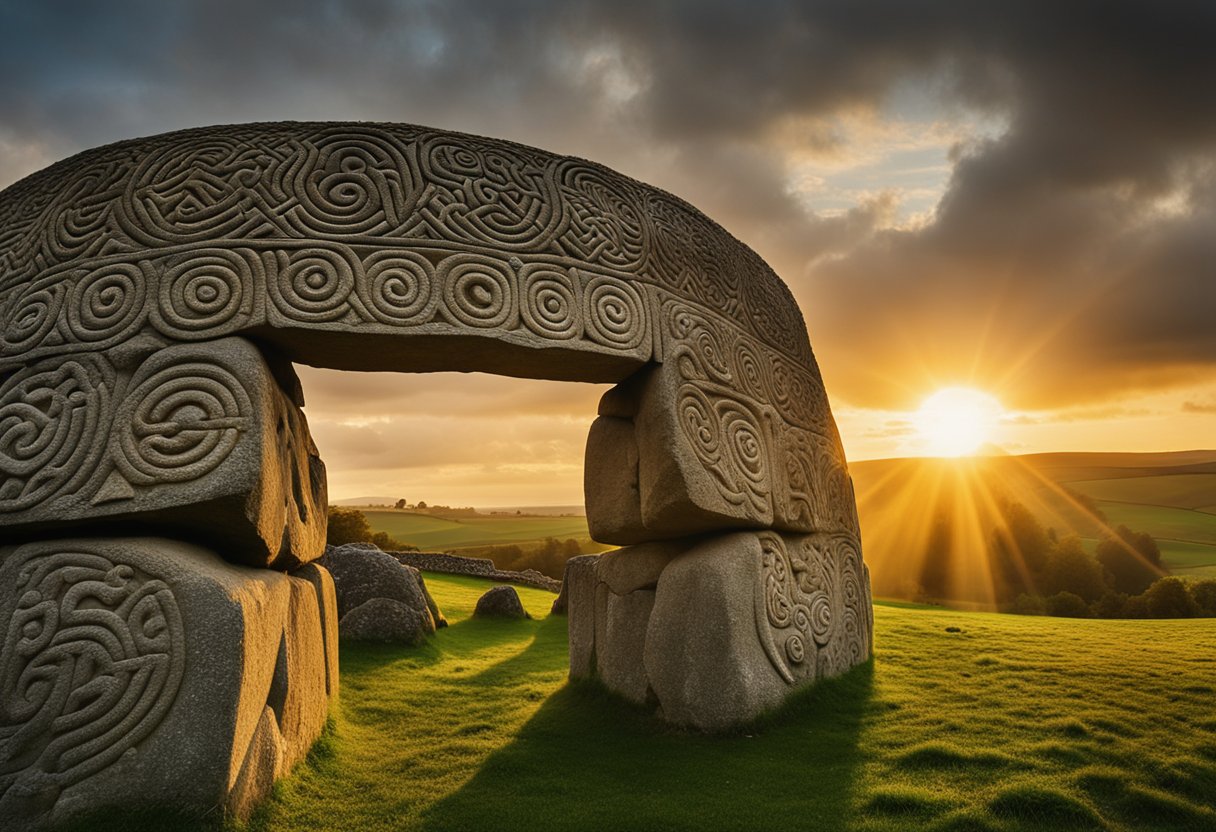The Newgrange: Ireland’s Ancient Astronomical Marvel Unveiled

Updated On: April 24, 2024 by Eman Sameh
Nestled within the lush Boyne Valley in Ireland lies The Newgrange, an archaeological gem that predates both the Great Pyramids of Giza and Stonehenge. This ancient passage tomb, believed to have been constructed around 3200 BC, is an embodiment of Ireland’s rich prehistoric heritage. Regarded as one of the most impressive monuments of its kind in Europe, Newgrange captures the imagination with its intricate megalithic art, grandeur, and architectural prowess, which has stood the test of millennia.

Constructed with a deep understanding of astronomy, Newgrange is famed for its winter solstice phenomenon where, on the shortest day of the year, a narrow beam of sunlight pierces the darkness of its inner chamber at dawn. This remarkable alignment between architecture and the movements of the sun is a key feature of Newgrange, indicating its importance not just as a burial site but also as a place of astronomical and spiritual significance. The monument’s enduring legacy is further evidenced by the cultural and religious importance ascribed to it in a landscape rich with Neolithic sites, contributing to our understanding of Ireland’s ancient past.
Newgrange stands as a testament to the astronomical knowledge and skill of the ancient people of Ireland, whose work continues to fascinate scholars and visitors alike. The site forms part of the Brú na Bóinne complex, a UNESCO World Heritage site that is recognised for its outstanding contribution to our global cultural heritage.
Historical Context and Discovery
Newgrange stands as a testament to Ireland’s rich Neolithic heritage, encapsulated in its grand mound structure that has intrigued both the scholarly community and the public for centuries. The discovery and subsequent studies of this ancient astronomical marvel have provided valuable insights into our prehistoric past.
Unearthing Newgrange
It was in the 17th century that Newgrange gained attention following its unintentional discovery by local farmers. Local folklore and historical records suggest that it was not entirely buried in obscurity before then. However, the visibility of the site was massively increased after 1699 when materials from the tomb were removed for road building, revealing the entrance to the passage and chamber within.
Early Studies and Excavations
Thomas Molyneux, a notable figure in early investigations, documented his observations in the 18th century. Later, in the 19th century, scholars such as George Petrie and Charles Vallancey undertook more systematic studies of Newgrange, contributing to the understanding of its structure and possible functions.
The 20th century saw Newgrange garner more systematic attention from the archaeological community, with the most significant excavations conducted by Professor Michael O’Kelly between 1962 and 1975. These extensive investigations unveiled much about the tomb’s construction, astronomical alignment, and artefacts, marking a monumental period in the understanding of Newgrange within the context of Irish and world prehistory.
The Newgrange Within Brú Na Bóinne

Newgrange stands as a testament to the sophisticated knowledge of prehistoric peoples, nestled within the Boyne Valley’s Brú na Bóinne complex. This area is recognised for its significant concentration of prehistoric monuments, including the large passage tombs of Knowth, Dowth, and, most notably, Newgrange itself.
The Complex of Monuments
- Location: Situated within the Boyne Valley, Newgrange forms part of a larger megalithic complex.
- Neighbouring Tombs: Newgrange is closely accompanied by other notable passage tombs, such as Knowth and Dowth, each with their own unique features and histories.
This complex is an archaeological marvel representing thousands of years of history, revealing much about the society that constructed these monumental structures. The placements and designs of these tombs indicate a deep-seated connection to celestial events.
UNESCO World Heritage Site
- Designation: In 1993, Newgrange, along with its counterparts Knowth and Dowth, was designated a UNESCO World Heritage Site.
- Criteria: The site fulfils the criteria of bearing a unique testimony to a cultural tradition and to exhibiting an important interchange of human values.
Being part of such a prestigious list emphasises the global importance of Newgrange within Brú na Bóinne, highlighting our shared heritage and the need to preserve such irreplaceable sites for future generations. This stamp of recognition by UNESCO ensures that the site continues to be protected and studied, furthering our understanding of humanity’s past.
Architectural Features
In our exploration of Newgrange, we focus on the monument’s striking architectural features. These elements reflect remarkable engineering skills and a sophisticated understanding of astronomical phenomena, signifying the importance of Newgrange to its builders.
Passage and Chamber
The passage tomb of Newgrange is a marvel of Neolithic construction. It consists of a long, narrow passageway leading to a central chamber. This central chamber, with a corbelled roof that has remained waterproof to this day, testifies to the ingenuity of its creators. Lined with large orthostats and roofed with overlapping stones, the passage and chamber align with the winter solstice sunrise, allowing light to flood the inner sanctum.
Kerbstone Artwork
At Newgrange, we find one of Europe’s most impressive examples of megalithic art. The kerbstones, encircling the passage tomb, are adorned with intricate carvings. The entrance stone, in particular, showcases a rich array of spiral designs that continue to baffle and fascinate. This artwork reflects a deep-seated cultural significance, likely related to the beliefs and practices of the Neolithic people who constructed this megalithic marvel.
Astronomical Alignment
Newgrange stands as a monument not only to Ireland’s prehistoric past but also to the astronomical knowledge of its builders. Intricately aligned with the cycles of the cosmos, the site showcases a sophisticated understanding of the movements of the Sun and Moon.
Winter Solstice Phenomenon
The Winter Solstice marks one of the most astonishing aspects of Newgrange. Each year, around the 21st of December, the sunrise penetrates the main passage through an opening known as the roof box. This event illuminates the chamber, revealing a profound connection between the construction of the tomb and the solar calendar. Our ancestors engineered this precise moment to coincide with the shortest day of the year, portraying their grasp of seasonal cycles.
Interplay with the Sun and Moon
While the Winter Solstice draws much attention, Newgrange’s alignment extends to other celestial events. Beyond the solstice, it is believed that the site also has intricate associations with the Equinoxes, when day and night are of equal length, and may have significance for lunar alignment, linking it to both the Sun and Moon. Such alignments highlight the importance of celestial bodies in the daily lives of those who built Newgrange, providing a window into their worldview and rituals.
Cultural and Religious Significance
Newgrange is not merely an ancient monument but a testament to Ireland’s profound cultural and religious heritage. This Neolithic structure dovetails the line between a temple and a tomb, showcasing its deep spirituality and ceremonial significance for prehistoric communities.
Rituals and Ceremonies
At Newgrange, the alignment with the winter solstice sunrise is evidence of its ceremonial use, where light floods the chamber on the shortest day of the year. This event likely served both as a timekeeping method and a potent spiritual symbol. Ceremonies during this time might have been conducted to honour the renewal of seasons or appease deities such as The Dagda, one of the Tuatha Dé Danann, who were revered in Irish myths.
Myths and Legends
The lore surrounding Newgrange is densely layered, connecting to various Irish myths. It is often linked to The Dagda, a chief god in Irish mythology, and associated with themes of fertility and abundance. Some tales suggest Newgrange was the site of an incestuous union between The Dagda and his daughter, with the intention of maintaining the divine bloodline. Furthermore, Newgrange is thought to be inhabited by mythical creatures, reinforcing its status within the spiritual landscape of Ireland.
Art and Carvings
At Newgrange, the ancient carvings testify to the Stone Age’s sophisticated knowledge of art. Remarkably, the tomb is adorned with a rich display of megalithic art, highlighted by the iconic spirals and geometric patterns.
Megalithic Art Interpretations
The most striking features of Newgrange are its megalithic art pieces, consisting of intricate carvings that decorate both the interior passage and the stones around the monument. Scholars believe these carvings hold astronomical significance or spiritual meaning, possibly relating to the passage tomb’s alignment with the winter solstice. Among the variety of shapes, the triple-spiral design stands out as the most famous, etched into the entrance stone and appearing within the central chamber.
Another remarkable feature is the use of quartz, a crystal often associated with transcendence and light, which was skilfully integrated into the monument’s façade. This suggests our Neolithic ancestors might have attributed a particular reverence or importance to this material, perhaps linking it to illumination or the worship of the sun.
As we inspect the monument’s carvings, we see a consistent theme of circles, arcs, and serpentine forms—motifs common to many structures from the Stone Age. Our understanding continually evolves, but these designs likely played a part in ceremonies or marked significant astronomical events for those who built Newgrange over 5,200 years ago.
Excavation and Conservation
In our continued exploration of Newgrange, we focus on the crucial aspects of archaeological excavation and the conservation efforts that preserve this remarkable site for future generations.
Modern Archaeological Methods
At Newgrange, state-of-the-art archaeological methods have been employed to uncover and understand the historical and cultural context of the monument. In particular, the work by Professor Michael J. O’Kelly played a pivotal role. His meticulous excavation aimed to discern as much as possible about the people who built Newgrange. Using modern techniques, O’Kelly’s work shed light on the tomb’s original appearance, which guided the monument’s reconstruction and conservation.
Excavation Highlights
- Utilisation of Radiocarbon Dating: Allowed precise determination of the tomb’s age.
- Geophysical Surveying Techniques: Additional structures surrounding Newgrange were revealed.
Preservation Efforts
Newgrange is not just a monument but a key part of Ireland’s heritage. Our preservation efforts are central to maintaining its integrity and legacy. The Office of Public Works manages the site, with the Brú Na Bóinne Visitor Centre as the starting point for visitors. The centre offers insights into the monument’s significance before visitors proceed to the site. Ongoing efforts ensure the structure remains unaltered by the elements and the passage of time while allowing visitors to experience its grandeur just as it was in the Neolithic era.
Conservation Strategies
- Visitor Management: To mitigate the impact of tourism, a timed-entry system safeguards against over-visitation.
- Environmental Monitoring: Ensuring the preservation of ancient art carvings and structural stability.
By embracing the legacy of people like Professor O’Kelly and Charles Campbell, we honour their contribution to archaeology. We continue their work and keep Newgrange’s history alive by updating and sharing this heritage.
Newgrange in Comparison
In our exploration of ancient structures, Newgrange stands out not only for its antiquity but also for its exceptional astronomical alignment.
Relation to Other Ancient Structures
When we examine Newgrange, the renowned passage tomb in Ireland, it becomes clear that our ancestors had a sophisticated understanding of engineering and astronomy. Newgrange, built around 3200 BC, is older than both Stonehenge and the Egyptian Pyramids, including the Great Pyramid of Giza. Despite its lesser fame, the tomb’s design reveals a remarkable knowledge of celestial events, particularly the winter solstice sunrise, which aligns perfectly with its entrance chamber—a feat of prehistoric engineering.
Like Newgrange, Stonehenge in England is a masterwork of megalithic construction associated with celestial observations. Its stones are aligned to frame important solar events. However, while Stonehenge’s exact purpose remains the subject of debate, Newgrange’s alignment and interior artwork leave little doubt about its ceremonial significance connected to the solstice.
Turning our gaze to Egypt, the Egyptian Pyramids, especially the Great Pyramid of Giza, are well-known for embodying precise astronomical alignments. The Pyramids were not only tombs but also bore religious and cosmological significance, much like Newgrange. However, these Egyptian marvels were built centuries after Newgrange and show how such grand constructions evolved with human civilization.
Comparably, the Orkney Islands’ Maeshowe, another Neolithic chambered cairn, shares similarities with Newgrange, including its solar alignment. Maeshowe’s entrance is aligned with the sunset during the winter solstice, further confirming that such astronomical considerations were widespread in ancient megalithic architecture.
In reflecting upon these ancient structures, we gain insight into prehistoric societies’ advanced knowledge and beliefs. Whether in Ireland, England, Egypt, or farther north in Orkney, there is a clear link between their constructions and the heavens, which reflects a profound interconnection between our ancestors and the cosmos.
Public Access and Interpretation
At Newgrange, we ensure that every visitor receives an immersive and educational experience deeply rooted in the ancient history and astronomical significance of this prehistoric site. We strive to provide access in a manner that both enlightens and respects the integrity of this UNESCO World Heritage Site.
Visitor Experience
Brú Na Bóinne Visitor Centre: Before setting foot at Newgrange itself, visitors begin their journey at the Brú Na Bóinne Visitor Centre. Here, one can engage with interactive exhibits that set the stage for the Newgrange monument. It’s an essential part of the visitor experience, providing context and background that enrich one’s understanding and appreciation of the site.
Guided Tour: To explore Newgrange, visitors must join a guided tour, which begins at the Brú Na Bóinne Visitor Centre. These tours are led by knowledgeable guides illuminating the site’s history and celestial alignments, most notably with the Winter Solstice. It’s a deeply informative and rewarding experience, revealing insights into Ireland’s Neolithic past.
Lottery: To witness the famed Winter Solstice phenomenon from within Newgrange, one must enter the annual lottery. This rare opportunity allows a select few to experience the tomb’s inner chamber illuminating as it aligns with the rising sun, an event marking the shortest day of the year.
Boyne Valley Tours: Besides the official guided tours, privately operated Boyne Valley Tours offer visitors another avenue to experience Newgrange. These tours often provide a broader look at the Boyne Valley region, which is rich in history and lore.
National Geographic: The significance of Newgrange and its place in the ancient world has not escaped global attention, with National Geographic frequently featuring the site in its publications. This recognition further validates the importance of Newgrange as a centre of prehistoric astronomy and engineering, thus adding to the prestige of the visitor experience.
In essence, Newgrange is not merely a visit to an ancient site but a comprehensive journey through Ireland’s Neolithic heritage, guided by the hands of those who strive to protect and interpret this marvel for future generations.
Newgrange in the Wider Context
Newgrange is not simply an isolated marvel but part of a grand tapestry of human history. Its construction during the Neolithic era and subsequent recognition as a UNESCO World Heritage Site underscores its global significance.
Global Significance and Influence
Newgrange is celebrated as one of the most important prehistoric monuments not only in Ireland but around the world. As a World Heritage Site, this testament to human ingenuity is on par with other renowned megalithic monuments such as Stonehenge. The expertise displayed in its construction during the Neolithic Monument period profoundly showcases our ancestors’ astronomical knowledge and architectural prowess.
Given its age, which predates even the Egyptian pyramids, Newgrange is crucial in understanding the puzzle of mankind’s early monumental endeavours. Its precise alignment with the winter solstice sunrise reflects a sophisticated understanding of astronomy. The attention to detail and significance placed on the solstice event at Newgrange elevates it beyond a mere historical artefact to an enduring legacy of astronomical observations practised by Neolithic societies.
As a Megalithic Monument, its influence stretches far, inspiring contemporary architecture and archaeoastronomy. Our appreciation of Newgrange as a marvel of prehistoric engineering informs our global discourse on ancient civilisations‘ abilities to harmonise their constructions with celestial events. It sets a standard for the convergence of cultural, historical, and astronomical interests, reminding us of the richness of our shared human experience.
Frequently Asked Questions
In this section, we address common queries about Newgrange, shedding light on its creators, age, photography opportunities, tickets, interior, and its connection with celestial events.
Who created Newgrange?
It is believed that a farming community of the Neolithic period constructed Newgrange and used it for agricultural, spiritual, and funerary purposes.
What is the age of Newgrange?
Newgrange is over 5,000 years old, built around 3200 BCE, making it older than both Stonehenge and the Great Pyramid of Giza.
How can one capture the winter solstice at Newgrange in photographs?
To photograph the winter solstice at Newgrange, one must apply for the annual lottery due to the limited capacity of the chamber or, alternatively, capture the exterior as the sun rises.
What are the procedures for obtaining tickets to Newgrange?
Tickets to Newgrange can be purchased from the Visitor Centre or their official website. Due to high demand, advance booking is strongly recommended.
Can you describe the interior of Newgrange?
The interior of Newgrange features a long passage leading to a central chamber with a corbelled roof. Intricate megalithic art adorns some of the large stones.
What is the relationship between Newgrange and celestial events?
Newgrange is precisely aligned with the rising sun on the winter solstice, where sunlight illuminates the inner chamber, showcasing its astronomical significance.






